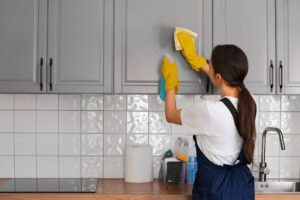Creating a sustainable home goes beyond energy-efficient appliances and recycling. Often overlooked are the cleaning hacks we use daily.
Did you know that many conventional cleaning products contain toxic chemicals harmful to both our health and the environment? With the rise of eco-conscious living, finding safe, effective alternatives using household ingredients has become essential.
Embracing eco-friendly cleaning not only reduces your carbon footprint but also promotes a healthier home. Here, you’ll discover practical and effective methods for cleaning that harness the power of nature. Read on.
The Truth About Conventional Cleaning Products
Many cleaning products contain harsh chemicals that can irritate your skin, exacerbate allergies, and even harm your pets. In fact, the Environmental Protection Agency (EPA) states that indoor air can be two to five times more polluted than outdoor air, often due to volatile organic compounds (VOCs) found in many commercial cleaners. Switching to eco-friendly alternatives made from common household ingredients can significantly improve air quality and create a safer environment.
Simple Ingredients for Eco-Friendly Cleaning
Before diving into the specific cleaning hacks, it’s essential to know what ingredients are both effective and eco-friendly. Here are a few staples to keep in your pantry:
- White Vinegar
- Baking Soda
- Lemon Juice
- Castile Soap
- Essential Oils
Effective Cleaning Hacks Using Household Ingredients
Now, let’s explore practical cleaning hacks that utilize these ingredients. From tackling tough stains to freshening up your space, these methods are not only efficient but also environmentally friendly.
All-Purpose Cleaner
Mix the same amount of water and white vinegar in a spray bottle. Shake it well before using. This cleaner works on many things like kitchen counters, bathroom sinks, and glass. It takes away dirt and kills germs. You can add a
few drops of essential oil if you want it to smell nice. It works as well as store cleaners, but it’s safer and cheaper.
Baking Soda for Deodorizing
Sprinkle baking soda on carpets, couches, or chairs. Let it sit for about 15 minutes. Then vacuum it up. It pulls out bad smells without using strong chemicals. The room will smell fresh and clean. You can also put an open box of baking soda in the fridge. It helps soak up food smells and keeps things smelling better.
Lemon Juice for Spot Cleaning
If you get a stain on your clothes, pour some lemon juice on it. Rub it in gently and then leave it in the sun for a few hours. The lemon breaks down the stain. The sun helps make white clothes look brighter. After that, wash the clothes like normal. This is good for small spots and light stains.
Castile Soap for Dishwashing
Use Castile soap instead of store-bought dish soap. It is safe and good for the earth. Put a little soap in warm water and mix it. Then wash your dishes like normal. It cleans off grease and food well. You can use it on plates, pans, and even baby bottles.
Essential Oils for Freshening Air
You can make your own air spray at home. Fill a spray bottle with water. Add a few drops of your favorite essential oil. Shake it and spray it in the room. It smells nice and fresh. Oils like lemon or eucalyptus can also help clean the air. It’s a safe way to make your home smell good.
Green Cleaning for Specific Areas
Different areas of your home require different cleaning methods. Here are eco-friendly hacks tailored for specific spaces:
Kitchen
The kitchen can get messy fast. Food, grease, and spills build up quickly. For your sink and stove, make a thick paste with baking soda and water. Rub it on with a sponge. Scrub until the grime comes off. Rinse with warm water when you’re done.
To clean the microwave, put water and lemon juice in a bowl. Heat it for five minutes. The steam helps loosen stuck-on food. Wipe it with a clean cloth. It will smell fresh too.
Bathroom
Bathrooms get soap scum and stains. Mix equal parts vinegar and water in a spray bottle. Use it on mirrors, sinks, tiles, and tubs. Spray it, wait a few minutes, then wipe clean. It cuts through buildup easily.
For toilets, pour one cup of baking soda into the bowl. Then add one cup of vinegar. It will fizz and bubble. Let it sit for a few minutes. Then scrub with a toilet brush and flush. It cleans and removes odors too.
Living Room
Dust can pile up on tables, shelves, and TVs. Make your own dust spray at home. Mix half a cup of vinegar with two cups of water. Put it in a spray bottle. Spray a little on a soft cloth, like microfiber. Wipe down wood, plastic, or glass. It picks up dust and doesn’t leave anything behind.
Cleaning Tips from the Experts
For those who prefer a bit of guidance, many professionals will show how to implement these eco-friendly cleaning hacks effectively. They emphasize the importance of regular cleaning to maintain a sustainable home and recommend creating a cleaning schedule to ensure all areas of your home receive proper attention.
Embracing a Sustainable Cleaning Routine
Using green cleaning tips helps both your home and the planet. You use fewer chemicals, which means cleaner air and safer surfaces. This is better for your health, your family, and even your pets.
You don’t have to change everything at once. Start small and take one step at a time. Try using baking soda for smells or vinegar for windows. These little changes can make a big difference over time.
When you clean with natural products, you save money too. Most green items are already in your kitchen. Plus, you make less waste, so it’s better for the Earth.
It’s a win-win for you and the world around you. Pick one or two eco-friendly ideas and try them today. Soon, you’ll have a clean, safe home and feel good about it too.
Eco-Friendly Cleaning Hacks for a Sustainable Home
Switching to eco-friendly cleaning practices may seem overwhelming, but with the right approach, it becomes manageable. Take action, and inspire others to create cleaner, sustainable home environments without harmful chemicals. Let’s work together towards a sustainable future and make a difference, one cleaning task at a time!
For more related topics, check out the rest of our blog!







